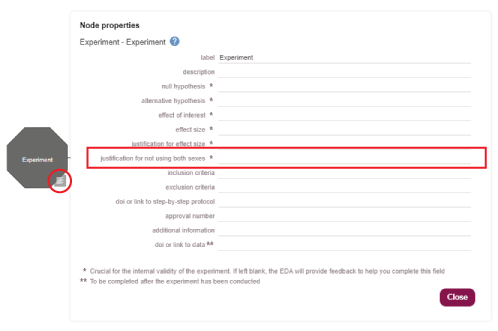Only one sex is being studied in this experiment
You have indicated you are only planning to use one sex in the properties of the animal characteristics node(s). You need to consider if using one sex is appropriate for your experiment, and if so, provide a justification for not using both sexes.
Is using one sex appropriate for your experiment?
The conclusions you can draw from your experiment will be limited by using animals of only one sex. Using male and female animals improves the external validity of an experiment as it enables generalisation of the findings to the whole population. Sex differences exist in disease prevalence, symptoms and progression, as well as in treatment efficacy and side effects. Large scale rodent studies also frequently show treatment effects differ between males and females.
Including both sexes in your experiment is not necessarily the same as specifically looking for sex differences and does not automatically require using more animals.
For more information about taking sex into account when designing experiments, click here.
Justifying not using both sexes
If you are only examining one sex you need to justify this design decision carefully. A lack of evidence for a difference between sexes does not mean a difference does not exist, and so is not an adequate justification for only studying one sex.
The justification for a single-sex experiment can be scientific or practical/logistical. An example scientific justification is that the process only occurs in one sex (e.g. oogenesis, or prostate or ovarian cancer). An example practical/logistical justification is that the experiment involves very rare samples (e.g. conservation studies where access to one sex is more difficult, or studies that include human tissue samples from rare diseases).
If you have already included a justification for not using both sexes you may disregard this message.
Checking if your experiment is sex-inclusive
To check if your experiment is sex-inclusive use the Sex Inclusive Research Framework, a decision tree with supporting guidance for each question. This guidance includes examples of both appropriate and inadequate justifications for single-sex experiments.
Changing the EDA diagram
Including both sexes
Should you decide to include both sexes in your experiment ensure you have an animal characteristics node for each sex. If you have animals with combinations of different characteristics (e.g. different genotypes and different sexes or different ages and different strains), ensure you have an animal characteristics node for each combination (see screenshot below).
Justifying not using both sexes
For a study not including both sexes add the justification in the properties of the Experiment node. To open the properties window click on the properties icon on the bottom right of the Experiment node (circled in red in the image below). Add justification information into the field ‘Justification for not using both sexes’ (outlined in red in the image below).

Please note if you modify the diagram the critique will need to be repeated.